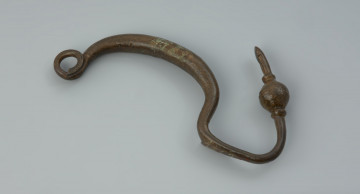
Buckle bail
BC 200 — 1
National Museum in Szczecin
Part of the collection: Antiquity
The massive bronze fibula was found in a bog, probably in the 1930s. It was probably a kind of a votive offering for an aquatic deity. The unique characteristics of a bog environment preserved the objects that were placed there in a perfect condition. The presented fibula is a rare and exceptional object of provincial Roman imports found in the Western Pomerania region. There is only one more object of this kind that was found in Czelin. Such fibulae were manufactured in foundry workshops operating in Roman settlements in Noricum and western Pannonia. A few different types of these ornaments were distinguished. The object from Świecianów, like most items of this type found on the Polish territories, represents a simple design and the most common type. Fibulae became popular in Roman provinces during the Julio-Claudian dynasty, especially during the reign of Tiberius and Claudius (14–54 AD). They are discovered in pairs, always in the graves of women. In the first half of the 1st century, fibulae started to occur in Barbaricum (outside the Roman Empire) with the earliest “Czech” import wave of Roman goods, of which they are a marker. The fibula should be culturally associated with the early settlements of the Wielbark culture or (which is less probable) with the late Oksywie culture and dated to the first half of the 1st century.
Monika Witek
Author / creator
Dimensions
cały obiekt: width: 3.7 cm
Object type
pin (fastener)
Technique
casting
Material
bronze
Creation / finding place
Owner
Muzeum Narodowe w Szczecinie
Identification number
Location / status